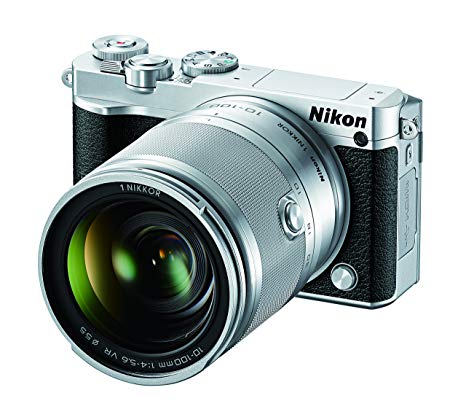Introduction Getting to know the camera
Being one of the recognized leaders in the production of SLR cameras, Nikon entered the market for compact system cameras rather modestly. Having survived the hype of 2011 with the release of the first Nikon J1 and V1 cameras , buyers have cooled to new models and switched to competitors, but in vain. Who but Nikon knows the secret to creating truly successful cameras? It was not necessary to watch the powerful breakthrough in the development of the Nikon 1 line, and now it offers models for every taste - from the flagship V3 to the only waterproof and shockproof AW1 among cameras with interchangeable lenses. With each new model, Nikon proves that their line of compact mirrorless cameras deserves the closest attention.
Get a quote Nikon 1 J5
Nikon 1 J5 is positioned as an amateur camera for those who have already outgrown their smartphone or compact and strive for better image quality, without putting tens and hundreds of thousands of rubles on expensive equipment. This small-looking camera may seem unnecessarily simple, but simplicity, as you know, is the key to success. The combination of minimalistic design, powerful stuffing and the optimal set of functions in a tiny case is a good reason to call the J5 a great camera for everyday shooting and an alternative to budget DSLR cameras. Do we have the right to do this? We will deal with the traditional large review “Week with an Expert”.
At first glance at the Nikon 1 J5, you pay attention to the tiny body - the camera looks like a real baby, especially when bundled with the 1 Nikkor 10-30mm f / 3.5-5.6 whale lens.
Compared to its predecessor, the J4, the camera has gone from the appearance of a bright smooth bar and began to look more traditional for a mirrorless mirror: its body is diluted with an insert under the skin, which gives the camera style and vintage. The colors are also offered exclusively classic: silver-black, silver-white and completely black.
For image quality Nikon 1 J5 meets the 1-inch CMOS-matrix CX format with a resolution of 20.8 megapixels. In size, it is several times larger than the matrix of compact cameras, but inferior to the sensors of the Micro Four Thirds format, also used in system cameras. The crop factor when shooting with interchangeable lenses is 2.7 - so, the equivalent focal lengths of the 1 Nikkor 10-30mm f / 3.5-5.6 whale lens will be 27–81 mm.
Currently, the J5 has the highest resolution of the entire Nikon 1 line, allowing you to take pictures as 5568 x 3712 pixels in a 3: 2 format. In addition, the sensor is made using technology with backlight, which is an advantage for shooting in low light. The absence of a smoothing filter on the sensor is also a nice feature that avoids low detail.
The new generation Expeed 5A processor breathed new life into the camera, improving images obtained at both low and high ISO values ??up to 12800. In addition, the camera has an impressive burst speed of 60 frames per second with fixed autofocus. With constant autofocus, the rate of fire drops to 20 frames per second, which, however, does not negate the envy of many owners of SLR cameras, who can only dream of such characteristics.
The new processor has expanded the possibilities of video shooting - now the Nikon 1 J5 is capable of recording videos in 4K format. True, he does it with a frequency of only 15 frames per second, so how popular the function will be is a question. But with the shooting of Full HD 60 p, there will definitely not be any problems. The camera supports shooting time-laps up to 300 frames with the ability to set time intervals.
The shutter in the Nikon 1 J5 is electronic (unlike the mechanics in the Nikon 1 V3). However, in the context of the hero of our review, this is rather an advantage that allows the camera to maintain compact dimensions and unprecedentedly fast speed. In addition, the electronic shutter does not make noise, which will allow you to become the quietest reportage photographer in the world.
One of the main advantages of the Nikon 1 J5 is the large 3-inch display on the rear panel. It has a resolution of 1,037,000 points and a rotary function, which the J4 predecessor could not boast of. The display is able to rotate 180 degrees to take a selfie (in this position, the mode is activated automatically), and it also conveniently folds for shooting with arms extended upwards. The screen supports touch control, which comes in handy for quick focusing and quick access to shooting parameters. Support for the Multitouch function allows you to enlarge the image on the screen with the touch of two fingers, as well as flipping through pictures without using buttons.
Like the rest of the Nikon 1 line , the J5 does not have an integrated viewfinder. In addition, opponents of using the screen for composition and focus will be even more disappointed to learn that using an external viewfinder (similar to Nikon 1 V3) is impossible due to the lack of a hot shoe. Whether this is good or not is impossible to say unequivocally. For example, I constantly use the viewfinder when shooting, but its absence from Nikon 1 J5 did not cause me any problems during the whole test.
Like many modern cameras, the Nikon 1 J5 supports NFC technology to instantly pair the camera with a mobile device. Pictures can also be transferred over Wi-Fi using the special application Wireless Mobile Utility, as well as resort to using this utility to remotely control the camera.


